Abstract
In this paper, the numerical simulation of crack propagation in microstructures of Al2O3/SiCn nanocomposite ceramic tool materials is carried out by means of a micromechanical model based on the Voronoi tessellation and the cohesive element theory in order to explore the relationship between microstructure morphologies and mechanical properties. The residual stress initiated due to the mismatch of thermal expansion coefficients and elastic modulus between matrix grains and nanoparticles is considered in the simulation. The effects of microstructure types and nanoparticle volume content on the residual stress field and the fracture behavior are analyzed, respectively.
Similar content being viewed by others
References
Xu CH, Huang CZ, Ai X (2007) Cutting behavior and related cracks in wear and fracture of ceramic tool materials. Int J Adv Manuf Tech 32:1083–1089
Song JP, Huang CZ, Lv M, Zou B, Liu HL, Wang J (2014) Cutting performance and failure mechanisms of TiB2-based ceramic cutting tools in machining hardened Cr12MoV mold steel. Int J Adv Manuf Tech 70:495–500
Gong JH (2001) Fracture mechanics of ceramic material. Press of Tsinghua University, Beijing
Karch J, Birringer R, Gleiter H (1987) Ceramics ductile at low temperature. Nature 330:556–558
Nakahira A, Niihara K, Hirai T (1986) Microstructure and mechanical properties of Al2O3-SiC composites. J Ceram Soc Jpn 94(8):767
Zhai J, Tomar V, Zhou M (2004) Micromechanical simulation of dynamic fracture using the cohesive finite element method. J Eng Mater Technol 126(2):179–191
Ren, XD (2010) Multi-scale based stochastic damage constitutive theory for concrete. PhD Thesis Shanghai: University of Tongji
Dugdale D (1960) Yielding of steel sheets containing slits. J Mech Phys Solids 8(2):100–104
Barenblatt GI (1962) The mathematical theory of equilibrium cracks in brittle fracture. Adv Appl Mech 7:55–129
Hillerborg A, Modeer M, Petersson PE (1976) Analysis of crack formation and crack growth in concrete by means of fracture mechanics and finite elements. Cem Concr Res 6(6):773–781
Lin, G (1998) Numerical investigation of crack growth behaviour using a cohesive zone model. PhD Thesis Geesthacht: University of Hamburg-Harburg
Lin G, Cornec A, Schwalbe KH (1998) Three-dimensional finite element simulation of crack extension in aluminium alloy 2024-FC. Fatigue Fract Eng M 21(10):1159–1173
Rahul-Kumar P, Jagota A, Bennison SJ, Saigal S, Muralidhar S (1999) Polymer interfacial fracture simulations using cohesive elements. Acta Mater 47(15):4161–4169
Rahul-Kumar P, Jagota A, Bennison SJ, Saigal S (2000) Interfacial failures in a compressive shear strength test of glass/polymer laminates. Int J Solids Struct 37(48–50):7281–7305
Tomar V (2008) Analyses of the role of the second phase SiC particles in microstructure dependent fracture resistance variation of SiC-Si3N4 nanocomposites. Model Simul Mater Sc 16(3):35001
Jie F, Chen P, Ni J (2013) Prediction of grinding force in microgrinding of ceramic materials by cohesive zone-based finite element method. Int J Adv Manuf Tech 68:1039–1053
Cheng, HM (2011) Multi-scale simulation study on nanocomposite ceramic tool materials. PhD Thesis Jinan: Shandong University
Espinosa HD, Zavattieri PD (2003) A grain level model for the study of failure initiation and evolution in polycrystalline brittle materials. Part I: theory and numerical implementation. Mech Mater 35(3):333–364
Ghosh S, Liu YS (1995) Voronoi cell finite element model based on micropolar theory of thermoelasticity for heterogeneous materials. Int J Numer Meth Eng 38(8):1361–1398
Liu Y, Kageyama Y, Murakami S (1998) Creep fracture modeling by use of continuum damage variable based on Voronoi simulation of grain boundary cavity. Int J Mech Sci 40(2):147–158
Bolander JE, Saito S (1998) Fracture analyses using spring networks with random geometry. Eng Fract Mech 61(5–6):569–591
Zhou, TT (2012) Simulation study on nano-scale interfacial behavior and micro-scale fracture behavior of ceramic tool materials. PhD Thesis Jinan: Shandong University
Zhou TT, Huang CZ (2015) Simulation of crack propagation in single phase ceramic tool materials. Comp Mater Sci 104:177–184
Alfred C, Ingo S, Karl-Heinz S (2003) On the practical application of the cohesive model. Eng Fract Mech 70(14):1963–1987
Tvergaard V, Hutchinson JW (1992) The relation between crack growth resistance and fracture process parameters in elastic-plastic solids. J Mech Phys Solids 40(6):1377–1397
Tvergaard V, Hutchinson JW (1994) Effect of T-stress on mode I crack growth resistance in a ductile solid. Int J Solids Struct 31:823–833
Tomar V, Zhai J, Zhou M (2004) Bounds for element size in a variable stiffness cohesive finite element model. Int J Numer Meth Eng 61:1894–1920
Levin I, Kaplan WD, Brandon D, Wieder T (1994) Residual stresses in alumina/SiC nanocomposites. Acta Metal Mater 42(4):1147–1154
Todd R, Bourke M, Borsa C, Brook R (1997) Neutron diffraction measurements of residual stresses in alumina/SiC nanocomposites. Acta Mater 45(4):1791–1800
Evans AG, Faber KT (1981) Toughening of ceramics by circumferential microcracking. J Am Ceram Soc 64(7):394–398
Liu, HL (2005) Study on the fabrication and cutting performance of ceramic tool materials based on multi-phase and multi-scale nanocomposite. PhD Thesis Jinan: Shandong University
Hou YY, Li L, Zhang JX (1996) Study on the microstructure and the toughening mechanism in Al2O3/SiCnano nanocomposites. J Electron Microsc 17(2):156–161
Yin ZB, Yuan JT, Wang ZH, Hu HP, Cheng Y, Hu XQ (2016) Preparation and properties of an Al2O3/Ti(C,N) micro-nano-composite ceramic tool material by microwave sintering. Ceram Int 42:4099–4106
Ohji T, Hirano T, Nakahira A, Niihara K (1996) Particle/matrix interface and its role in creep inhibition in alumina/silicon carbide nanocomposites. J Am Ceram Soc 79(1):33–45
Zhao H, Jin ZZ (1996) The analysis of residual stress and toughening mechanism for particle-reinforced composite ceramic material. J Chin Ceram Soc 24(5):491–497
Niihara K, Nakahira A (1991) Strengthening and toughening mechanisms in nanocomposite ceramics. Ann Chim Fr 16(4):479–486
Levin I, Kaplan WD, Brandon DG, Layyous AA (1995) Effect of SiC submicrometer particle size and content on fracture toughness of alumina–SiC "nanocomposites". J Am Ceram Soc 78(1):254–256
Zavattieri PD, Espinosa HD (2001) Grain level analysis of crack initiation and propagation in brittle materials. Acta Mater 49(20):4291–4311
Author information
Authors and Affiliations
Corresponding author
Rights and permissions
About this article
Cite this article
Zhou, T., Yi, M. Microscopic cracking simulation of nanocomposite ceramic tool materials under the consideration of residual stress. Int J Adv Manuf Technol 94, 3485–3502 (2018). https://doi.org/10.1007/s00170-016-9663-4
Received:
Accepted:
Published:
Issue Date:
DOI: https://doi.org/10.1007/s00170-016-9663-4




